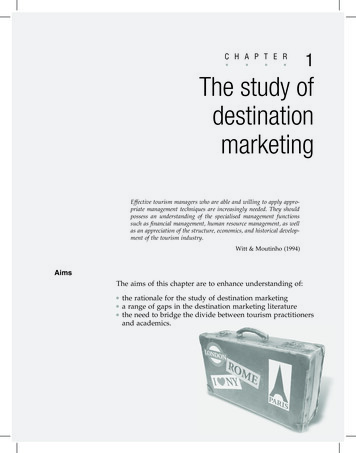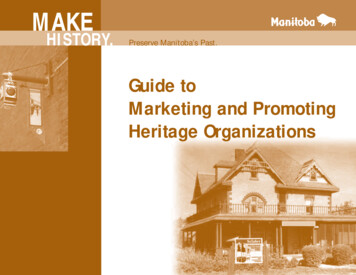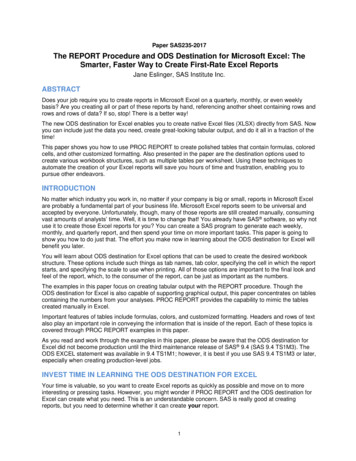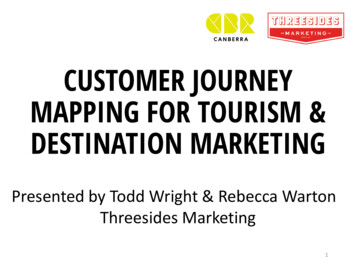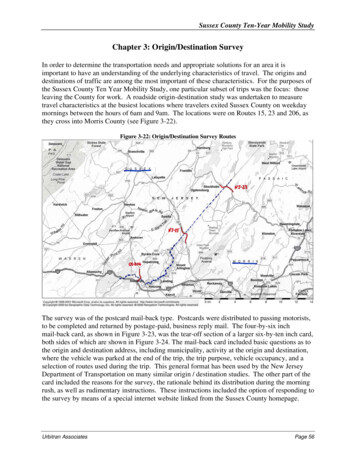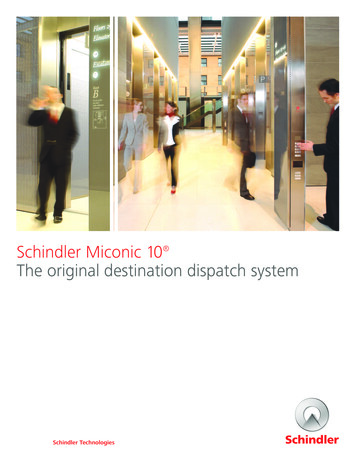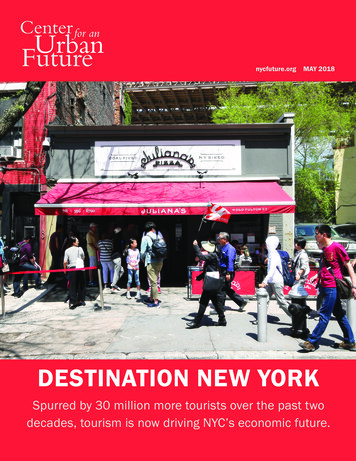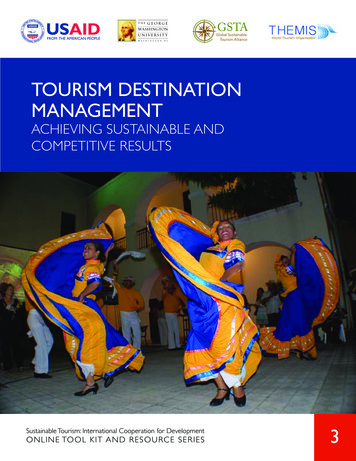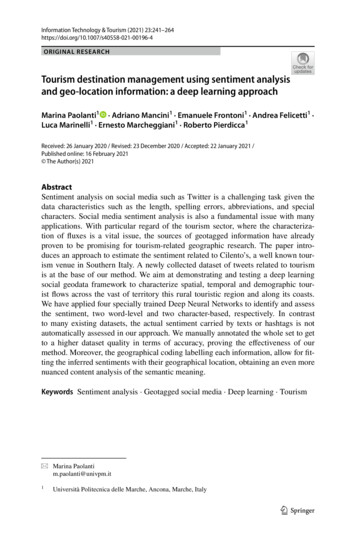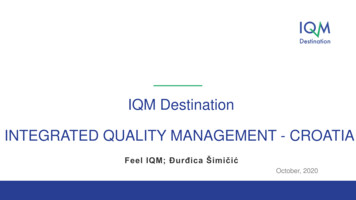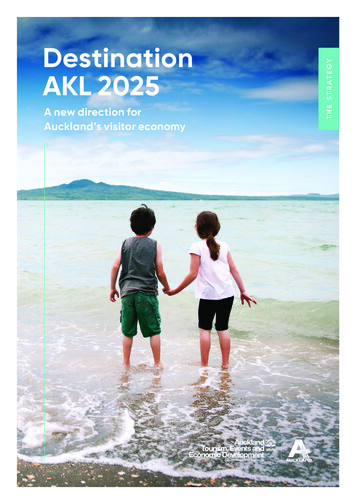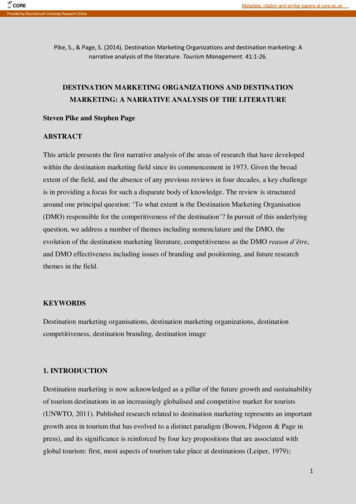
Transcription
COREMetadata, citation and similar papers at core.ac.ukProvided by Bournemouth University Research OnlinePike, S., & Page, S. (2014). Destination Marketing Organizations and destination marketing: Anarrative analysis of the literature. Tourism Management. 41:1-26.DESTINATION MARKETING ORGANIZATIONS AND DESTINATIONMARKETING: A NARRATIVE ANALYSIS OF THE LITERATURESteven Pike and Stephen PageABSTRACTThis article presents the first narrative analysis of the areas of research that have developedwithin the destination marketing field since its commencement in 1973. Given the broadextent of the field, and the absence of any previous reviews in four decades, a key challengeis in providing a focus for such a disparate body of knowledge. The review is structuredaround one principal question: ‘To what extent is the Destination Marketing Organisation(DMO) responsible for the competitiveness of the destination’? In pursuit of this underlyingquestion, we address a number of themes including nomenclature and the DMO, theevolution of the destination marketing literature, competitiveness as the DMO reason d’être,and DMO effectiveness including issues of branding and positioning, and future researchthemes in the field.KEYWORDSDestination marketing organisations, destination marketing organizations, destinationcompetitiveness, destination branding, destination image1. INTRODUCTIONDestination marketing is now acknowledged as a pillar of the future growth and sustainabilityof tourism destinations in an increasingly globalised and competitive market for tourists(UNWTO, 2011). Published research related to destination marketing represents an importantgrowth area in tourism that has evolved to a distinct paradigm (Bowen, Fidgeon & Page inpress), and its significance is reinforced by four key propositions that are associated withglobal tourism: first, most aspects of tourism take place at destinations (Leiper, 1979);1
second, the United Nations World Tourism Organisation (UNWTO) proposed thatdestinations were “the fundamental unit of analysis in tourism” (WTO, 2002); third,destinations have emerged as the biggest brands in the travel industry (Morgan, Pritchard &Pride, 2002), and lastly, a large number of nations, states and cities are now funding aDestination Marketing Organisation (DMO) as the main vehicle to compete and attractvisitors to their distinctive place or visitor space. Therefore, not only has the destination anddestination marketing emerged as a central element of tourism research (Wang & Pizam2011, Fyall, Garrod & Wang 2012), it is associated with the operational activities undertakenin the highly competitive business of attracting visitors to localities. While this in itself is nota new activity (see Ward 1995 for a historical analysis), what is new is the scale and extent ofthis highly competitive activity as acknowledged by Ashworth and Page (2011) in relation tourban tourism, which equally applies to all types of destinations.1.1 Aims of this analysisA review of the first 40 years of destination marketing research is challenging for at least tworeasons. First, this is a broad field with a diversity of research topics, spread across up to 150English language tourism-related journals (see Goeldner, 2011) including the Journal ofDestination Marketing and Management established in 2012, and an unknown number ofnon-tourism journals, which examine the DMO from a supply perspective, consideringthemes as varied as destination information systems, the politics of DMO governance,destination lifecycles, stakeholder collaboration, brand identity development, funding, andmarketing communications; while the demand (consumer-traveller) perspective includesissues such as consumer perceptions, decision making, and loyalty. Second, while someProgress in Tourism Management articles have been underpinned by previous papers thatcommented on discrete elements of destination marketing (see for example Buhalis & Law2008, Weed 2009, Ashworth & Page 2011) and reviews of contemporary themes such as thegrowth of medical tourism destinations (see for example Connell, 2013), no prior review ofthe destination marketing field was identified in a search of the literature. Indeed, Noel Scottposted a list of 182 published tourism related literature reviews on TRINet (5/9/12)1,1TRINET is an online discussion group comprising over 2000 tourism academics with postings made byindividual and replies and discussion freely occurring.2
following input from listserve members, which did not contain any references to an analysisof the destination marketing literature.Therefore, given the field is now well established after four decades of academic work withmany Faculties now offering modules in Destination Marketing, a ‘situation analysis’ mightbe helpful to map out and provide a critical discussion of the field (Fyall, Garrod & Wang,2012). However, following Weed (2009), this analysis does not attempt an ‘epiphanic’approach, which would lay claim to identifying a single truth of past, present and futureresearch due to the arrival of the field’s ‘maturity’ or ‘turning point’ that just happens tooccur at the time of writing the review. Instead, the aims of the review are two-fold: first, weseek to identify and provide an overview of the subject’s emergence and a coherent roadmapof the key research themes that have emerged since the first studies were published in theearly 1970s, and secondly, to provide a summary of possible future research agendasstructured around the principal theme of the review – the role of the DMO in leadingdestination marketing.1.2 Structure of this analysisTo provide a focus for the review, the paper is structured in the following way: i) the analysiscommences with a discussion of the key challenge of delimiting the field, includingnomenclature and the DMO; ii) the evolution of the destination marketing literature is thensummarised; iii) a destination marketing framework is proposed with sustainedcompetitiveness presented as the DMO reason d’être; iv) DMO effectiveness in the pursuit ofdestination competitiveness is discussed under the themes of destination brand identitydevelopment, destination positioning and marketing performance measurement tracking; v)the paper concludes with a summary of possible future research themes in the field.2. UNDERSTANDING DESTINATION MARKETING RESEARCH: DELIMITINGTHE FIELDA destination represents an amalgam of a diverse and eclectic range of businesses and people,who might have a vested interest in the prosperity of their destination community; although3
research on small and micro businesses has indicated that not all stakeholders are necessarilyinterested in the viability of the destination, when their principal objective for operating abusiness is lifestyle (Thomas, Shaw & Page, 2011). Nevertheless, the success of individualtourism ventures and cooperatives will depend to some extent on the competitiveness of theirdestination (Pike, 2004) and the leadership of the amalgam of stakeholders associated withthe tourism industries (Leiper, 2008). Emerging research empirically testing this propositionincludes SMEs’ dependence on DMO resources in Finland (Seppala-Esser, Airey & Szivas,2009) and hotel performance in Spain (Molina-Azorin, Periera-Moliner & Claver-Cortes,2010). Therefore, if the main focus for marketing leadership of a destination is the DMO,then a critical understanding of the development of destination marketing by DMOs is vital tounderstanding the factors and circumstances that may constrain or facilitate the effectiveexecution of their destination marketing function. In fact the marketing and promotion ofdestinations is now a ubiquitous activity, aided by the rise in new technological innovationssuch as social media which many destinations have harnessed in varying degrees (see forexample Hays, Page and Buhalis, 2013 for a review of the rise of Web 2.0 and how DMOshave harnessed it).2.1 Applied and fragmented nature of the destination marketing literatureMuch of the initial stimulus for destination marketing emerged from the germane area oftourism marketing, its evolution the subject of excellent syntheses (see for example Gilbert,1989) which provided the foundations for the development of this more specialised literaturefocused on the destination. In a subsequent review by Ritchie (1996), it was argued thattourism marketing research had been undertaken by those with a market orientation.Likewise, destination marketing research has by its very nature been undertaken byacademics with an interest in applied studies that address relevant challenges faced bypractitioners, rather than pure or basic research. There are a number of exceptions such asAshworth and Voogd (1990) which made very clear distinctions about the contribution ofgeography to place-marketing: such studies argued that places are unique and their marketingwas not a simple process of translating conventional marketing theory and practice derivedfrom goods and services marketing, a feature reiterated in recent synthesis of the role eventscan play in transforming cities (Richards & Palmer, 2010). Other recent research onevolutions in service dominant logic and its application to marketing in tourism have4
illustrated the shift in thinking towards co-creation and co-production in the way businessesand destinations can now engage with their customers (Shaw, Williams & Bailey, 2011).Despite these distinct geographical contributions to research on cities as destinations, it isevident as Malhotra (1996) argued that destination marketing research is generally concernedwith the application of theories and techniques to identify and contribute towards solvingmarketing management decision problems. Thus, the field has been characterised by afragmented applied research approach rather than theory building. Knight (1999), whoidentified a similar approach in the services marketing literature, suggested this ischaracteristic in the early development of many academic fields.Certainly there has been a lack of conceptual ideas, as well as replication studies to re-testfindings in destination marketing research. Ryan raised this issue on the TRINet discussionlist (30/7/08), by citing comments made by Pearce in 1991 that there had been a general lackof comparative research in the tourism field. One possible reason for this is that there is littleeditorial journal space available for replication studies, though there is more recent evidenceof a changing position at least in the case of destination image research in the key tourismjournals in terms of replicating previous studies beyond individual case studies. Anotherplausible reason has been the nature of continuous change occurring in the tourism macroenvironment, stimulating new research directions. Few other industries have evolved asquickly as tourism has during the past few decades (Jafari, 1993). Many transformations haveoccurred within the tourism sector since the destination marketing literature commenced inthe early 1970s, which have had wide ranging implications for DMOs. Among these changeswere the introduction of jet aircraft, privatisation and the outsourcing of government services,the demise of communism, global recognition of sustainability issues, explosion in mediachannels, globalisation, disintermediation and online distribution, informationcommunications technologies (ICT) and social media networking, the decline of thetraditional passive all inclusive coach tour and the rise of independent travellers and travelpackages, the rise of short breaks and emergence of low cost carriers and last minute discountpricing, and resurgence of cruising, backpackers, adventure travellers and ecotourism, darktourism and medical tourism; and the rise of terrorism and ensuing security measures, all ofwhich have stimulated research on the implications for destinations. In other words, manyone-off studies have failed to yield an interconnected and critical body of knowledge that hascontested and debated key findings as is evident in other areas of tourism that are5
underpinned by a distinct disciplinary focus such as geography, economics or psychology.But perhaps more concerning for the emergent subject has been the lack of debate andanalysis over key concepts and terms associated with the destination as a phenomenon asacknowledged by Fyall et al (2012).2.2 Nomenclature and the DMODespite the key role played by destinations in any modelling of the tourism system, there isno widely accepted definition of the term destination. Most studies of the destinationrecognise the seminal contribution of Leiper (Hall & Page, 2010) in formulating many of theideas that remain in current use in tourism research. In Leiper’s (1979) model, a destinationis a place the consumer travels to temporarily, from the region they reside in, creating atourism flow (demand) in both time and space. Subsequent development of the destinationconcept expanded the distinction between the demand and supply perspectives identifying acritical role for the DMO in seeking to promote the destination to connect better the supplyand demand aspects of tourism to maximise the use of destination resources (Pike, 2008).From the DMO supply-side the destination is defined by a political boundary, ranging from acontinent, a country, a state, a province, to a city or town or even a specific micro scale placewhere there may also be competing industry-led groups seeking to promote a place orproduct-focus for a place. However, destination might be perceived quite differently from thedemand perspective (Ryan, 1991), such as a geographic space in which a cluster of tourismresources exist. Thus the traveller’s intended destination could be a precinct within a politicalboundary (e.g. Surfers Paradise in the city of Gold Coast, Australia), a political boundary(e.g. the state of Queensland, Australia), or cut across conventional political boundariesand/or b
marketing communications; while the demand (consumer-traveller) perspective includes issues such as consumer perceptions, decision making, and loyalty. Second, while some Progress in Tourism Management articles have been underpinned by previous papers that commented on discrete elements of destination marketing (see for example Buhalis & Law 2008, Weed 2009, Ashworth & Page 2011)
